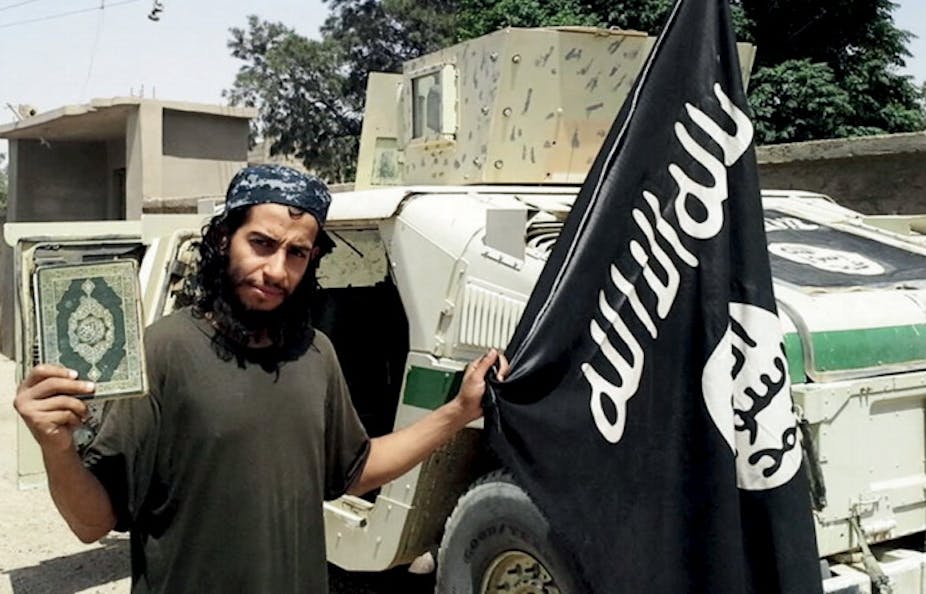The Islamic State (IS) attacks on Paris represent a major shift in the group’s strategy. The response has already been spectacular; increased military action is underway, as is a manhunt for attackers and accomplices still on the loose.
In the flurry of activity, it’s easy to forget that these attacks did not come out of nowhere. It pays to ask why IS attacked Paris specifically, why it did so now – and why it has suddenly adopted a new approach.
As IS’s statement of responsibility indicated, France was probably chosen as its first Western target because of the government’s active involvement in the anti-IS coalition, its intervention against Islamists in Mali, the state’s strong secularism – which prohibits public displays of religion including the hijab – and the depiction of the Prophet Muhammad, both by the satirical magazine Charlie Hebdo and the newspaper Liberation, which republished the notorious Danish cartoons of 2007.
France’s proximity to the Syrian conflict and its large Muslim population – from which an estimated 1,200 citizens have travelled to Iraq and Syria – also makes it a more accessible target than the US.
The Paris attacks were meant to play to two audiences: supporters of IS and its adversaries. In its statement following the attacks, IS claimed that the attacks were in retaliation for France’s airstrikes in Iraq and Syria: “This attack is the first of the storm and a warning to those who wish to learn.”
This was a warning to Western states involved in the anti-IS coalition that the group has reach in their countries and is able to launch planned and co-ordinated acts abroad.
In addition, the attacks furthered the group’s propaganda efforts by dominating media headlines and focusing attention on the organisation. This would have the knock-on effect of rallying IS supporters and inspiring new recruits.
The decision to target Paris and the associated propaganda boost IS has received is a worrying development, as it may continue to seek to offset its difficulties in Iraq and Syria by launching ever more dramatic attacks against the West.
Why now?
IS’s ability to recruit fighters and gain support within jihadist circles relates directly to its ability to gain and hold territory. This has meant that it has focused on expanding its territory in Iraq and Syria and acquiring affiliate provinces. Until recently, targeting states outside of the region has not been a priority for the group.
This focus is changing because IS has come under increasing pressure in the region, facing ground operations by Kurdish and Iraqi forces and airstrikes by the US-led coalition and Russia.

IS lost control of the town of Sinjar in north-western Iraq on November 12 when Kurdish Peshmerga forces recaptured it. This cut the group’s supply lines between its main base in Raqqa, Syria and its stronghold in Mosul, Iraq. Iraqi troops have had success of their own by encircling IS-held Ramadi in anticipation of an upcoming assault on the city.
The group’s membership and leadership is also being targeted and degraded. The US announced on November 13 that the British terrorist known as “Jihadi John” had apparently been killed in a strike in Raqqa. And on November 14, it was announced that an airstrike had killed the IS leader in Libya, Abu Nabil, aka Wissam Najm Abd Zayd al-Zubaydi. If the reports are true, his death would be a blow to one of IS’ strongest affiliates and marks the first confirmed US strikes against IS’ Libyan leadership.
These setbacks have eroded some of IS’s formidable reputation in jihadist circles, as its singular feat of capturing and holding territory is starting to crumble. This is especially true as other groups, such as the al-Qaeda affiliate Jabhat al-Nusra, have begun to expand their territory in Syria.
In order to maintain its pre-eminence over other organisations, and thereby continue to benefit from the associated support and flow of fighters, IS must demonstrate its continued relevance in spite of its stalled expansion. And it appears to be doing that by expanding its focus to include attacks against the “far enemy”.
The group’s losses in Iraq and Syria have coincided with other attacks outside its traditional areas of operation. In addition to the Paris attacks, these have included two bombings in Beirut on November 12, and possibly the October 31 bombing of a Russian Metrojet flight over Egypt which was claimed by IS affiliate Wilayat Sinai.
IS was also implicated in a bombing in Ankara on October 10, but has not claimed responsibility for that attack.
Different from an al-Qaeda attack
Not only are these attacks geographically farther away, but they are increasingly ambitious in nature. IS’ previous ventures abroad were limited to inspiring lone wolf attacks in its name, rather than having any formal planning role. But the level of coordination in the Paris attacks indicates that the central IS organisation may very well have been involved. If that’s the case, it would represent the first time that the group has coordinated an attack inside a Western state.
High-profile attacks against the West are exactly what al-Qaeda used to build its reputation. But so far, IS has not fully adopted al-Qaeda’s approach – and while the Paris attacks demonstrated planning and involved simultaneous coordinated attacks, an al-Qaeda hallmark, they were also waged against relatively “soft” targets. Al-Qaeda tended to mount more operations against “hard targets” such as Western aircraft, buildings and embassies.
During the January 2015 Charlie Hebdo attack in Paris, the al-Qaeda affiliate AQAP targeted very few bystanders and focused instead on those associated with the publication. On the other hand, as demonstrated by the Paris attacks and the claim of responsibility, IS targets civilians – both Muslim and Western.
Put simply, Islamic State’s game has changed. But however much a surprise the Paris attacks were, the change has been coming for some time.

